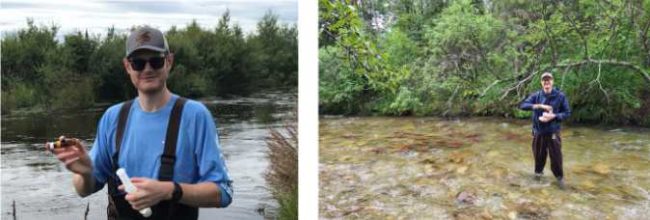
A major concern about mine development in Alaska’s Bristol Bay region and in many watersheds throughout Alaska is the potential for toxic waste to contaminate water and threaten world class salmon runs. Copper is a particular concern because it is acutely toxic to fish at relatively low concentrations.
The U.S. Environmental Protection Agency (EPA) uses a model to predict copper toxicity to aquatic organisms. The model results are used to establish water quality guidelines. How well this model works under water chemistry conditions in Alaskan watersheds is poorly understood, however, and risk assessments using this model could be underestimating toxic levels of copper.
Seeking to resolve this uncertainty, researchers at the University of Alaska Fairbanks completed a study to determine the acute lethality of copper to sockeye, coho and Chinook salmon. They conducted these studies with salmon at the swim-up fry life stage, a time when salmon can be the most vulnerable to toxins in the water. In comparing their findings to those predicted by the U.S. EPA model, the research team confirmed that under the water conditions found in the Bristol Bay region, the toxicity predictions of the EPA model are underestimated.
“This is really important for the Bristol Bay watershed” said College of Fisheries and Ocean Sciences graduate student Drew Porter, who worked on the project under advisors Dr. Benjamin Barst and Dr. Matthew Wooller. The team also included Dr. Jeffrey Morris at Abt Associates. The project was funded by Alaska Sea Grant.
Porter explained that copper is toxic to fish, even in relatively low concentrations, and the freshwaters supporting salmon species within the Bristol Bay watershed have water chemistry characteristics (dissolved organic carbon and hardness) that do not attenuate the toxicity of copper to fish. He said to accurately predict copper toxicity, it is important to consider a suite of water chemistry factors, as well as differences among fish species.
To run the toxicity tests, Porter first collected water samples from tributaries in the Bristol Bay watershed and compared them against samples from Poker Creek near the UAF campus to establish that this local creek has dissolved organic carbon concentrations and hardness similar to conditions found in the Bristol Bay watershed. Chinook, sockeye and coho salmon fry obtained from the Alaska Department of Fish and Game were then exposed, in a flow-through aquaria system using the Poker Creek water, to five different copper concentrations. The experiment also included a control group with no copper exposure.
After documenting the mortality in each aquarium at each treatment level to determine empirical lethal copper concentrations, the researchers used the EPA model to generate lethal concentration predictions for comparison. The model-derived predictions of toxic levels were higher for all three salmon species, demonstrating that the model underpredicted copper toxicity. The experiments also demonstrated differences among species in sensitivity to copper.
“Copper sensitivities were lowest for sockeye, intermediate for Chinook, and highest for the coho salmon fry,” said Porter. “These findings are concerning given the propensity of coho salmon to spend greater lengths of time rearing in streams in the Bristol Bay region than Chinook or sockeye salmon.”
The study highlights the need to update the model and approach used nationally to predict copper toxicity and establish water quality criteria. These empirical data are useful for increasing the accuracy of copper toxicity risk assessments for Pacific salmon species at a sensitive juvenile life stage under Alaskan water conditions.
Porter also pointed out that exposure to low levels of copper can affect a salmon’s sense of smell, impacting their ability to identify and return to their natal streams. He said future study could look at sublethal concentrations of copper and their impacts to Pacific salmon species.
Porter is graduating with his master’s degree and will spend the next year working with NOAA as an Alaska Sea Grant State Fellow.
Source: Alaska Sea Grant
